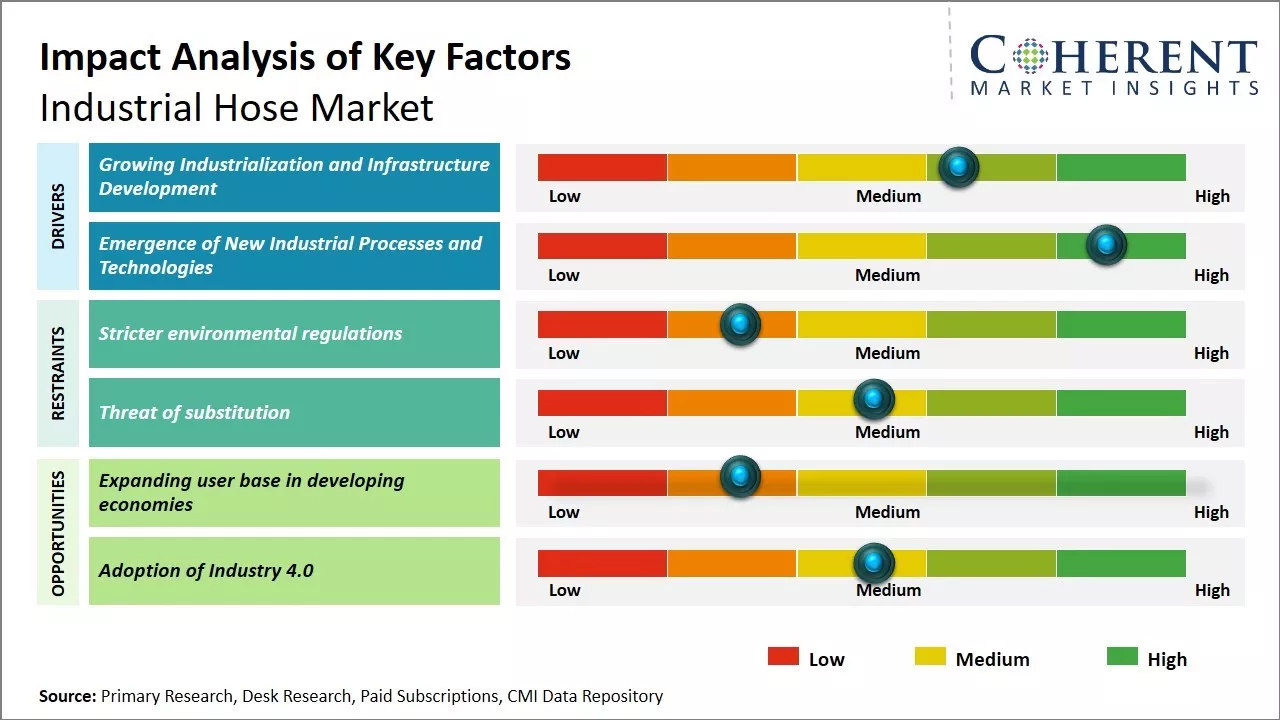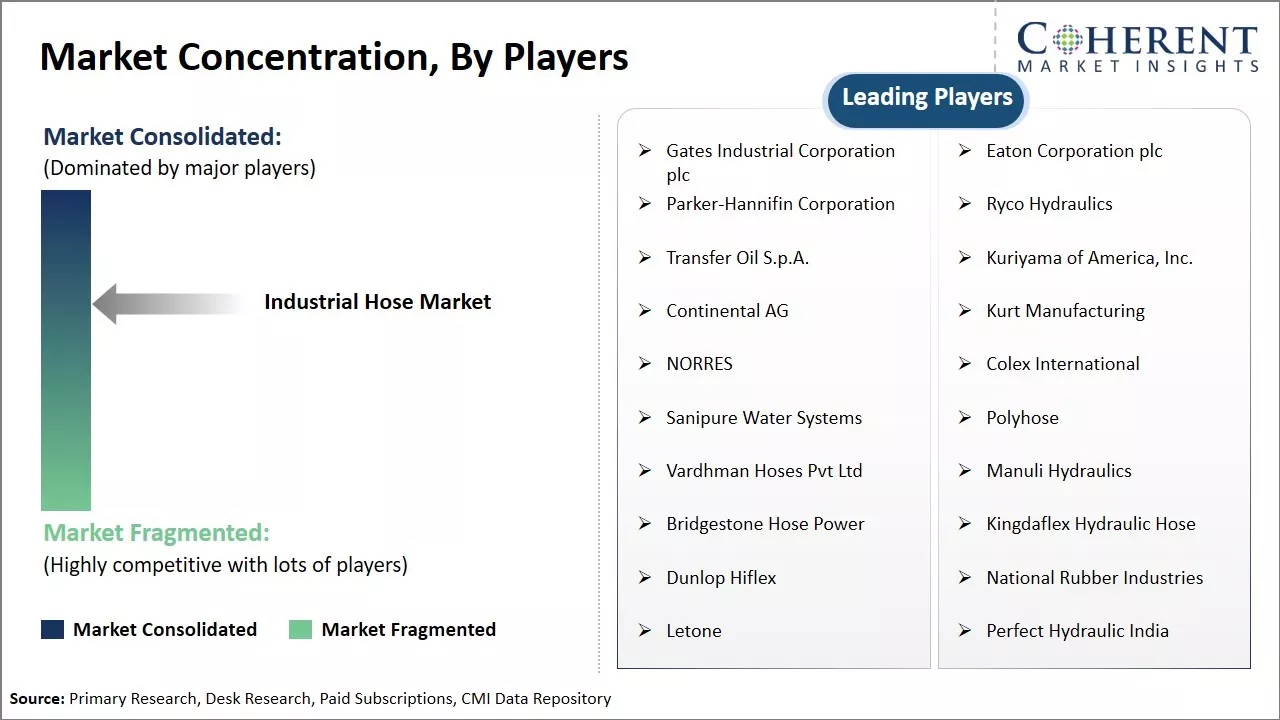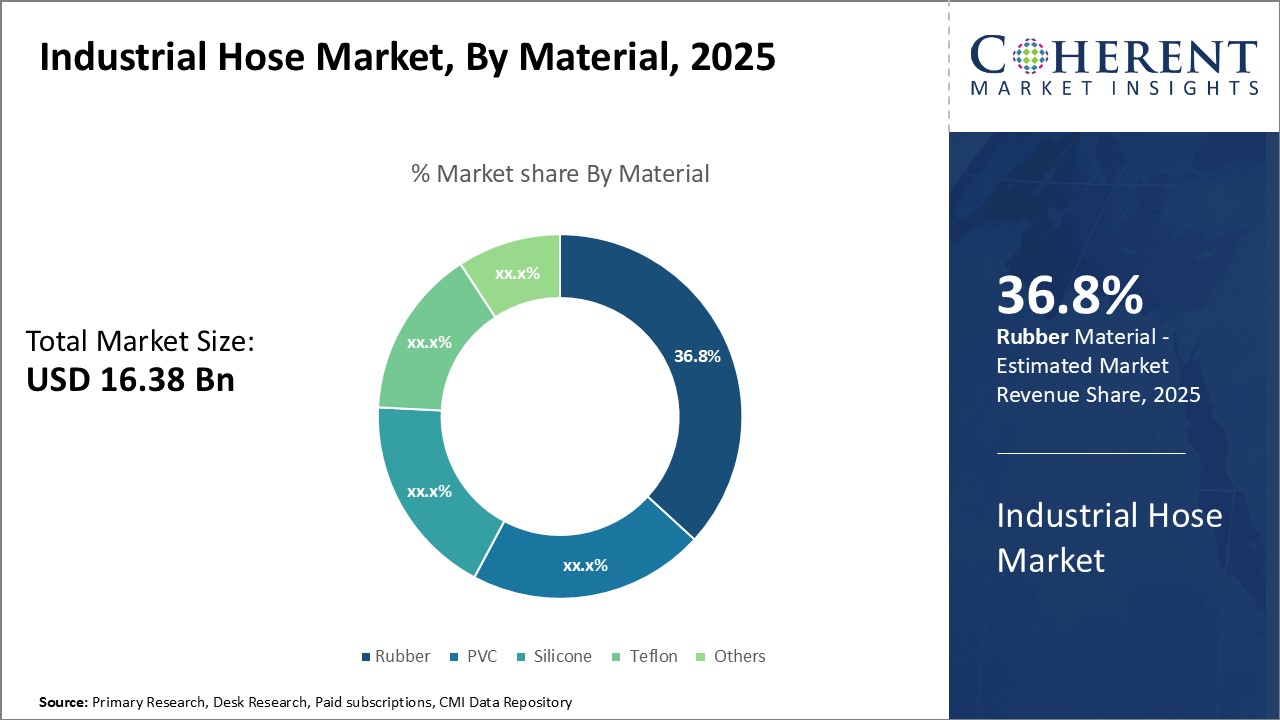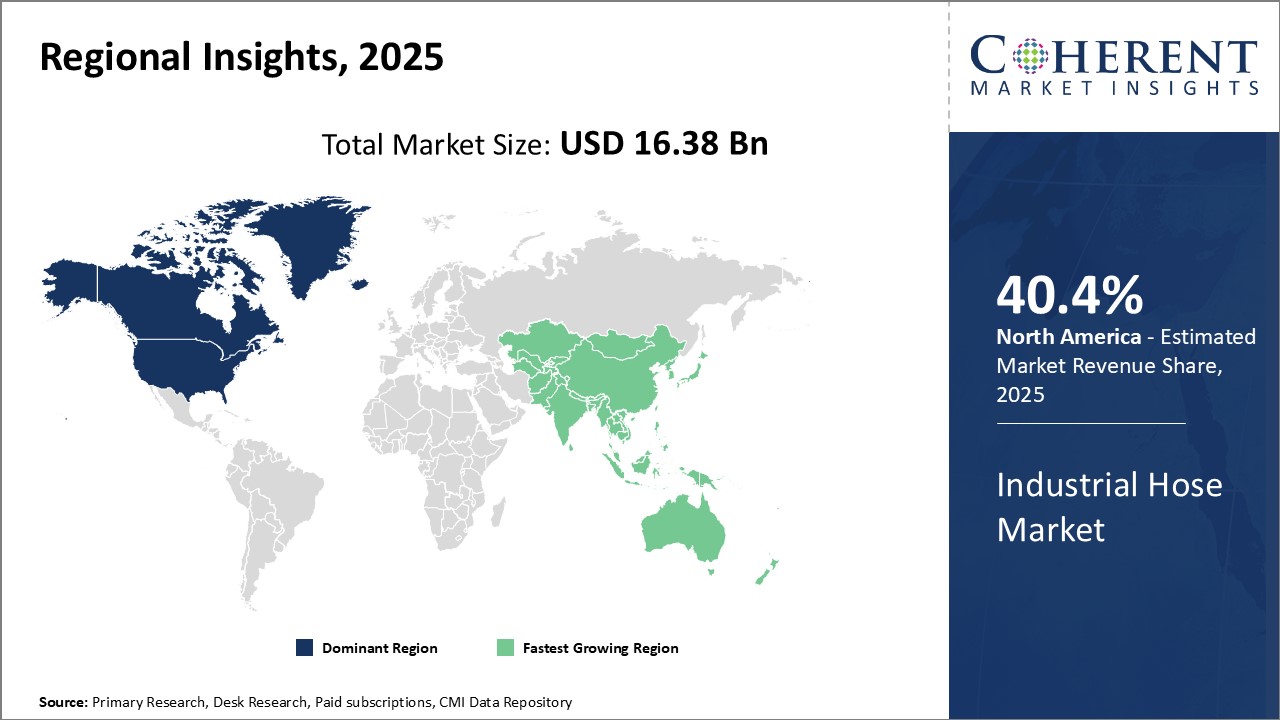Industrial Hose Market Size and Trends
Global industrial hose market is estimated to be valued at US$ 16.38 Bn in 2025 and is expected to reach US$ 32.15 Bn by 2032, exhibiting a compound annual growth rate (CAGR) of 10.1% from 2025 to 2032.

Discover market dynamics shaping the industry: Download Free Sample
Global industrial hose market is expected to witness positive growth over the forecast period. Rising demand from the construction sector is expected to drive the market growth. Key ongoing and upcoming construction projects such as roads, bridges, buildings is expected to boost demand for industrial hoses. Further, growing automotive industry is also expected to contribute to the growth of the industrial hose market. In the automotive industry, hoses are used for several applications such as radiator hoses, fuel lines, and ventilation systems among others. These factors are expected to boost demand for industrial hoses during the forecast period.
Growing Industrialization and Infrastructure Development
With rapid urbanization and globalization, there has been significant growth in industrialization and infrastructure development across major economies worldwide. Various industries such as oil & gas, chemical, mining, food processing, construction, agriculture, and others are expanding operations and producing at larger capacities. This has tremendously boosted demand for industrial hoses that are used for a wide range of material handling applications in these industries. Whether its transportation of crude oil, chemicals, slurries, food items or construction materials - hoses play a critical role in conveying fluids and bulk products within the industrial premises and across locations. Government investments in building new roads, bridges, ports, power plants, factories, commercial spaces, and others have also boosted the need for hoses. As the scale of operations grows, requirement rises for reliable and durable hoses that can withstand harsh conditions and ensure smooth operations over longer usage cycles without interruptions. This has propelled the industrial hose market growth as manufacturers are focusing on developing hoses with advanced polymer formulations, robust engineering designs and wider product portfolios to suit the application needs of various industries. Growing industrialization and infrastructure development are expected to drive the market growth. For instance, according to the data by Invest India in 2022, India's infrastructure is anticipated to expand at a compound annual growth rate (CAGR) of almost 7% during the forecast period.
Market Concentration and Competitive Landscape

Get actionable strategies to beat competition: Download Free Sample
Emergence of New Industrial Processes and TechnologiesWith advancing technologies, new industrial processes are continuously emerging which put emphasis on performance, efficiency and safety. This evolution is opening up opportunities for enhanced hoses required to handle new type of fluids and materials. For instance, developing economies are investing heavily in renewable energy sources like solar, wind, hydro, tidal, and others. Construction of solar farms, wind turbines, desalination plants needs specialized hoses equipped to function under heavy duty cycles and harsh environmental conditions over extended life. 3D printing technology is revolutionizing the manufacturing sector with polymers, metals and composites being used as raw materials. This calls for specialized conductive and non-conductive hoses capable of precisely metering and dispensing varied materials. Even industries like oil extraction are adopting techniques like hydraulic fracturing that involve pumping of toxic chemicals into wells under high pressure. Such processes necessitate hoses made from premium materials offering high chemical resistance along with ability to withstand wide range of temperatures and pressure levels.

To learn more about this report, Download Free Sample
Market Challenges: Stricter environmental regulationsGlobal industrial hose market faces several challenges. Stricter environmental regulations around the globe require manufacturers to produce hoses made from more sustainable materials. This increases production costs. End users are more cost-conscious due to economic uncertainty, demanding lower prices from suppliers. Hose makers must invest in technology to drive efficiencies while maintaining product quality. Geopolitical tensions also impact sourcing and trade.
Market Opportunities: Expanding user base in developing economies
Expanding user base in developing economies boosts need for reliable hoses that can withstand tough working conditions. Demand arises from sectors like oil and gas, mining, construction and infrastructure development. Technology innovations allow hoses to tolerate higher pressures and temperatures. Lightweighting hoses reduces costs of transportation and operations. Growing adoption of automation across industries opens up prospects.

Discover high revenue pocket segments and roadmap to it: Download Free Sample
Insights, By Material: Durability and Flexibility Define Rubber HosingRubber segment is estimated to contribute 36.8% market share in the industrial hose market in 2025, in terms of material used. Rubber hoses are extremely durable and flexible, and these make them suitable for a wide variety of industrial applications. Rubber hoses can withstand high pressures and temperatures, physical impact, and corrosion from chemicals better than other materials. Their flexibility allows them to be bent, coiled and generally maneuvered with ease. This flexibility is important for industrial processes that require hoses to be frequently moved, re-routed or re-positioned. Rubber hoses protect contents being transferred and provide leak-proof sealing better than other materials. The elastic properties of rubber allow hoses to deform under pressure without breaking seal. Rubber hoses are also lightweight, an important factor for mobile equipment and automation. Their resistance to oil, chemicals and solvents make rubber hoses ideal for transfer of hazardous fluids in industries like oil & gas, chemical and food processing. Rubber hoses can be custom designed in various dimensions and shapes to interface with machinery and pipe connections seamlessly. Years of proven performance and reliability have created deep institutional and industry familiarity with rubber hoses that leads to increased preference and specification by equipment manufacturers and end-users. Hence, increasing crude oil production and investment is boosts usage of rubber hosing. According to the Canadian Association of Petroleum Producers (CAPP), capital investment in Alberta’s oil sands is expected to increase from US$ 6.7 billion in 2020 to US$ 7.3 billion in 2021.
Insights, By Media Type: Versatile Applications Drive Others (Chemical, etc.)Segment Others (Chemical, etc.) segment is estimated to contribute the 38.1% share of the industrial hose market, when segmented by media type. Chemical hoses are used for efficiently and safely transfer of a very wide range of fluids from acids and alkalis to solvents and slurries. Chemical hoses must be non-reactive to transported media and be able to withstand high pressures, temperatures, and chemical exposures without permeating or degrading. These also need flexibility to maneuver around process equipment and into complex piping arrangements.
PVC and silicone hoses dominate the chemical hose market due to their inertness to most chemicals while retaining flexibility. PVC hoses can handle acids and bases of moderate concentration along with alcohols and ketones. Silicone hoses offer the broadest chemical compatibility, withstanding exposure to solvents, acids, and bases and oxidizing agents, and are able to operate at higher temperatures than most other hose materials. Food-grade hoses find limited use in some chemical and pharmaceutical applications involving non-toxic transport. The many complex transfer requirements across the diverse chemical industry uphold strong, ongoing demand for hoses designed specifically for this sector.
Insights, By Industry: Large Infrastructure Drives Oil & Gas Segment Dominance
Oil & Gas segment is estimated to account for the 38.4% share of the industrial hose market, when segmented by industry. This is due to its reliance on an enormous network of offshore and onshore pipelines, rigs, refineries and storage infrastructure that require hoses for various fluid transfer applications. Oil & gas exploration and production and petroleum refining have very challenging hose requirements to handle highly flammable, volatile or corrosive fluids like petroleum, LNG, LPG and petrochemicals. Hoses used must have robust inner tubes and covers resistant to hydrocarbons and ability to withstand high working pressures and temperatures. Specialized hoses like cryogenic hoses are needed to transport LNG at extremely low temperatures. Additionally, the sector necessitates hoses adaptable for subsea, marine and other harsh outdoor environments. It also demands hoses suitable for tough working conditions like extreme weather, vibrations and hazardous areas. The large scale of the global oil & gas network translates to huge ongoing consumption of purpose-engineered hoses.
Regional Insights

Need a Different Region or Segment? Download Free Sample
North American region has established itself as the dominant region in the global industrial hose market with estimated 40.4% share in 2025. This can be attributed to strong presence of manufacturing industries across Canada and the U.S. The region is home to some of the largest manufacturing companies in the world, especially in key industries such as oil & gas, construction, automotive, mining and chemical processing. These industries are heavy users of industrial hoses for various fluid transfer applications, providing a steady demand base in the region. In addition, North American manufacturers offer a wide range of technologically advanced hoses and fittings, catering to diverse industrial needs. Their emphasis on research and development has allowed them to introduce customized solutions tailored for specific applications. Local manufacturing also ensures just-in-time delivery and reduces dependency on imports.
The Asia Pacific region is emerging as the fastest growing market for industrial hoses. Rapid industrialization and infrastructure development across China, India, Southeast Asia and other developing nations is driving significant growth. Countries are investing heavily in manufacturing facilities, power projects, transportation networks and more. This is generating substantial opportunities for industrial hose suppliers in the region. For example, China has become a global manufacturing powerhouse, catering to both domestic and overseas demand. Indian companies are also expanding aggressively. The availability of cheap labor and resources is attracting many international players to set up local factories. Meanwhile, ASEAN nations like Vietnam, Indonesia and Thailand offer favorable business conditions to industries. All of these developments are translating into higher demand for hoses from a wide range of end-use sectors. The Asia Pacific market also benefits from the presence of cost-competitive hose manufacturers based in China and other parts.
Market Report Scope
Industrial Hose Market Report Coverage
| Report Coverage | Details | ||
|---|---|---|---|
| Base Year: | 2024 | Market Size in 2025: | USD 16.38 Bn |
| Historical Data for: | 2020 To 2024 | Forecast Period: | 2025 To 2032 |
| Forecast Period 2025 to 2032 CAGR: | 10.1% | 2032 Value Projection: | USD 32.15 Bn |
| Geographies covered: |
|
||
| Segments covered: |
|
||
| Companies covered: |
Gates Industrial Corporation plc, Eaton Corporation plc, Parker-Hannifin Corporation, Ryco Hydraulics, Transfer Oil S.p.A., Kuriyama of America, Inc., Continental AG, Kurt Manufacturing, NORRES, Colex International, Sanipure Water Systems, Polyhose, Vardhman Hoses Pvt Ltd, Manuli Hydraulics, Bridgestone Hose Power, Kingdaflex Hydraulic Hose, Dunlop Hiflex, National Rubber Industries, Letone, Perfect Hydraulic India |
||
| Growth Drivers: |
|
||
| Restraints & Challenges: |
|
||
Uncover macros and micros vetted on 75+ parameters: Get instant access to report
Market Segmentation
- Material Insights (Revenue, USD Bn, 2020 - 2032)
-
- Rubber
- PVC
- Silicone
- Teflon
- Others
- Media Type Insights (Revenue, USD Bn, 2020 - 2032)
-
- Water
- Oil
- Hot Water and Steam
- Air and Gas
- Food and Beverage
- Others (Chemical, etc.)
- Industry Insights (Revenue, USD Bn, 2020 - 2032)
-
- Oil & Gas
- Chemical
- Food & Beverage
- Pharmaceuticals
- Agriculture
- Others
- Regional Insights (Revenue, USD Bn, 2020 - 2032)
- North America
- U.S.
- Canada
- Latin America
- Brazil
- Argentina
- Mexico
- Rest of Latin America
- Europe
- Germany
- U.K.
- Spain
- France
- Italy
- Russia
- Rest of Europe
- Asia Pacific
- China
- India
- Japan
- Australia
- South Korea
- ASEAN
- Rest of Asia Pacific
- Middle East & Africa
- GCC Countries
- Israel
- Rest of Middle East & Africa
- North America
- Key Players Insights
- Gates Industrial Corporation plc
- Eaton Corporation plc
- Parker-Hannifin Corporation
- Ryco Hydraulics
- Transfer Oil S.p.A.
- Kuriyama of America, Inc.
- Continental AG
- Kurt Manufacturing
- NORRES
- Colex International
- Sanipure Water Systems
- Polyhose
- Vardhman Hoses Pvt Ltd
- Manuli Hydraulics
- Bridgestone Hose Power
- Kingdaflex Hydraulic Hose
- Dunlop Hiflex
- National Rubber Industries
- Letone
- Perfect Hydraulic India
Share
Share
Missing comfort of reading report in your local language? Find your preferred language :
Transform your Strategy with Exclusive Trending Reports :
Frequently Asked Questions
EXISTING CLIENTELE
Joining thousands of companies around the world committed to making the Excellent Business Solutions.
View All Our Clients
